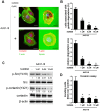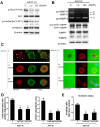Impact of flavonoids on matrix metalloproteinase secretion and invadopodia formation in highly invasive A431-III cancer cells
- PMID: 23991004
- PMCID: PMC3749203
- DOI: 10.1371/journal.pone.0071903
Impact of flavonoids on matrix metalloproteinase secretion and invadopodia formation in highly invasive A431-III cancer cells
Abstract
Metastasis is a major cause of mortality in cancer patients. Invadopodia are considered to be crucial structures that allow cancer cells to penetrate across the extracellular matrix (ECM) by using matrix metalloproteinases (MMPs). Previously, we isolated a highly invasive A431-III subline from parental A431 cells by Boyden chamber assay. The A431-III cells possess higher invasive and migratory abilities, elevated levels of MMP-9 and an enhanced epithelial-mesenchymal transition (EMT) phenotype. In this study, we discovered that A431-III cells had an increased potential to form invadopodia and an improved capacity to degrade ECM compared with the original A431 cells. We also observed enhanced phosphorylation levels of cortactin and Src in A431-III cells; these phosphorylated proteins have been reported to be the main regulators of invadopodia formation. Flavonoids, almost ubiquitously distributed in food plants and plant food products, have been documented to exhibit anti-tumor properties. Therefore, it was of much interest to explore the effects of flavonoid antioxidants on the metastatic activity of A431-III cells. Exposure of A431-III cells to two potent dietary flavonoids, namely luteolin (Lu) and quercetin (Qu), caused inhibition of invadopodia formation and decrement in ECM degradation. We conclude that Lu and Qu attenuate the phosphorylation of cortactin and Src in A431-III cells. As a consequence, there ensues a disruption of invadopodia generation and the suppression of MMP secretion. These changes, in concert, bring about a reduction in metastasis.
Conflict of interest statement
Figures





Similar articles
-
Effects of dietary flavonoids, luteolin, and quercetin on the reversal of epithelial-mesenchymal transition in A431 epidermal cancer cells.Cancer Sci. 2011 Oct;102(10):1829-39. doi: 10.1111/j.1349-7006.2011.02035.x. Epub 2011 Aug 10. Cancer Sci. 2011. PMID: 21752154
-
Effects of luteolin and quercetin, inhibitors of tyrosine kinase, on cell growth and metastasis-associated properties in A431 cells overexpressing epidermal growth factor receptor.Br J Pharmacol. 1999 Nov;128(5):999-1010. doi: 10.1038/sj.bjp.0702879. Br J Pharmacol. 1999. PMID: 10556937 Free PMC article.
-
Dissecting the functional domain requirements of cortactin in invadopodia formation.Eur J Cell Biol. 2007 Apr;86(4):189-206. doi: 10.1016/j.ejcb.2007.01.003. Epub 2007 Mar 6. Eur J Cell Biol. 2007. PMID: 17343955
-
Invading one step at a time: the role of invadopodia in tumor metastasis.Oncogene. 2014 Aug 14;33(33):4193-202. doi: 10.1038/onc.2013.393. Epub 2013 Sep 30. Oncogene. 2014. PMID: 24077283 Free PMC article. Review.
-
The interplay between the proteolytic, invasive, and adhesive domains of invadopodia and their roles in cancer invasion.Cell Adh Migr. 2014;8(3):215-25. doi: 10.4161/cam.27842. Cell Adh Migr. 2014. PMID: 24714132 Free PMC article. Review.
Cited by
-
Flavonoids Luteolin and Quercetin Inhibit RPS19 and contributes to metastasis of cancer cells through c-Myc reduction.J Food Drug Anal. 2018 Jul;26(3):1180-1191. doi: 10.1016/j.jfda.2018.01.012. Epub 2018 Feb 13. J Food Drug Anal. 2018. PMID: 29976410 Free PMC article.
-
LFG-500 inhibits the invasion of cancer cells via down-regulation of PI3K/AKT/NF-κB signaling pathway.PLoS One. 2014 Mar 11;9(3):e91332. doi: 10.1371/journal.pone.0091332. eCollection 2014. PLoS One. 2014. PMID: 24618693 Free PMC article.
-
Metadherin regulates actin cytoskeletal remodeling and enhances human gastric cancer metastasis via epithelial-mesenchymal transition.Int J Oncol. 2017 Jul;51(1):63-74. doi: 10.3892/ijo.2017.4002. Epub 2017 May 17. Int J Oncol. 2017. PMID: 28534938 Free PMC article.
-
The Cytotoxic and Antimigratory Activity of Brazilin-Doxorubicin on MCF-7/HER2 Cells.Adv Pharm Bull. 2018 Aug;8(3):507-516. doi: 10.15171/apb.2018.059. Epub 2018 Aug 29. Adv Pharm Bull. 2018. PMID: 30276148 Free PMC article.
-
Molecular targets of luteolin in cancer.Eur J Cancer Prev. 2016 Jan;25(1):65-76. doi: 10.1097/CEJ.0000000000000128. Eur J Cancer Prev. 2016. PMID: 25714651 Free PMC article. Review.
References
-
- Chaffer CL, Weinberg RA (2011) A perspective on cancer cell metastasis. Science 331: 1559–1564. - PubMed
-
- Liotta LA, Stetler-Stevenson WG (1990) Metalloproteinases and cancer invasion. Semin Cancer Biol 1: 99–106. - PubMed
-
- Weaver AM (2006) Invadopodia: specialized cell structures for cancer invasion. Clin Exp Metastasis 23: 97–105. - PubMed
Publication types
MeSH terms
Substances
Associated data
- Actions
LinkOut - more resources
Full Text Sources
Other Literature Sources
Molecular Biology Databases
Research Materials
Miscellaneous

